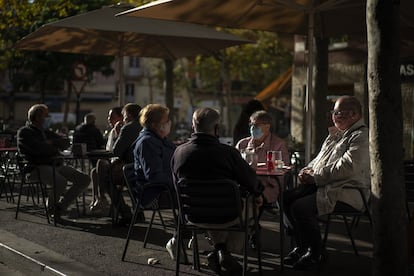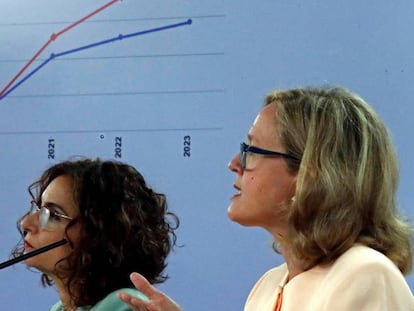Spanish Health Ministry reports nearly 12,000 new coronavirus infections, adds 209 victims to the death toll
The number of admissions in Spain’s intensive care units is rising, with the percentage of beds occupied by Covid-19 patients in the Madrid region exceeding 37%

A total of 11,970 new coronavirus cases were reported by the Spanish Health Ministry on Wednesday, toward the higher scale of the numbers seen over recent weeks. On Tuesday new infections came in at 7,118, a figure that may have been artificially low due to underreporting over the long weekend (Monday was a national holiday in Spain). In total, there have been 908,056 confirmed coronavirus infections in the country since the pandemic took hold.
The worsening infection rates are also reflected in the number of victims. In one day, Spain’s regions reported 209 Covid-related fatalities, bringing the official death toll to 33,413. This total does not, however, include the thousands of undiagnosed fatalities from the first wave of the epidemic in Spain. According to data from civil registries, there have been 53,000 excess deaths in the country between March and September.
The number of intensive care admission has risen to 190, compared to 164 on Tuesday and 157 last week
The 14-day cumulative number of coronavirus cases per 100,000 inhabitants, the most trustworthy figure in terms of monitoring the current situation of the health crisis, came in at 265 in Spain as a whole, according to the Health Ministry’s Wednesday report. On Tuesday that data point was 263, and one week ago it was 257. The regions where the indicator is highest are Navarre, with 774 (130 points up on last week), the North African city of Melilla, with 515 (157 up on last week), and Madrid, with 463 (down 128 on last week). The regions with the best figures are the Canary Islands (83), Valencia (101) and Cantabria (115).
All of Spain’s regions are far from the limit of just 14 coronavirus cases per 100,000 inhabitants that was considered at the start of the lockdown deescalation process in June by the Spanish authorities. In fact, at the end of that month, the average in Spain was 8.77 and only Madrid, Castilla-La Mancha and Castilla y León came in above 14.
In Catalonia, which yesterday announced the two-week closure of bars and restaurants in a bid to bring down infection rates, the current 14-day cumulative number of coronavirus cases per 100,000 inhabitants was 263, up 70 on last week. In Asturias, which has opted to return to a series of restrictions that resemble “Phase 2” of the central government’s deescalation plan, the number comes in at 186.
As a consequence of the progressive rise in cases, the number of patients in Spain’s intensive care units (ICUs) is also going up. Admissions over the last two weeks are currently at 190, compared to 164 on Tuesday and 157 last week. The percentage of ICU beds across the country that are currently occupied by Covid-19 patients has risen from 17.85% to 18.76% in a week. In the Madrid region, the percentage is at 37.56%. This exceeds the 35% limit that the country’s regions agreed on several weeks ago as one of three criteria that will see stricter coronavirus measures implemented. Madrid is currently under a state of alarm imposed by the central government for exceeding these three criteria, with a perimetral lockdown of nine municipalities, including the Spanish capital, currently in place. Of Spain’s 17 regions and two North African exclave cities, only Madrid and Melilla currently exceed the 35% limit.
In one day, Spain’s regions reported 209 Covid-related fatalities, bringing the official death toll to 33,413
Another of the criteria established by Spain’s regions and the Health Ministry is the positivity rate of PCR tests – i.e. the percentage of positive coronavirus diagnoses compared to the total carried out. This indicator is also rising gradually, from 8.2% on October 7 to 10.8% on Wednesday. The World Health Organization has stated that this figure should be below 5%, a rate that would indicate that there are few cases and that many tests are coming back negative – i.e. that positive cases are being controlled.
Spain’s regions established a maximum rate of 20% for this indicator, a level only exceeded currently by the North African cities of Ceuta and Melilla. But the parameter has a catch: it depends on how many tests are being carried out. Seven days ago, 758,000 were reported; in Wednesday’s report, 695,000. That’s to say, nearly 64,000 fewer.
This fall is due in a large part to the Madrid region, whose positivity rate has fallen from 18.5% to 17.7%. The number of tests carried out in Madrid, meanwhile, has dropped from 134,000 to 72,000 in a week. Experts warn that in an area with so many cases, carrying out fewer tests means a lack of scientific rigor. Sources from the regional government, meanwhile, argue that a total of 60,000 antigen tests have been carried out instead. But the problem is that the results of these analyses are not being reported.
English version by Simon Hunter.
Tu suscripción se está usando en otro dispositivo
¿Quieres añadir otro usuario a tu suscripción?
Si continúas leyendo en este dispositivo, no se podrá leer en el otro.
FlechaTu suscripción se está usando en otro dispositivo y solo puedes acceder a EL PAÍS desde un dispositivo a la vez.
Si quieres compartir tu cuenta, cambia tu suscripción a la modalidad Premium, así podrás añadir otro usuario. Cada uno accederá con su propia cuenta de email, lo que os permitirá personalizar vuestra experiencia en EL PAÍS.
¿Tienes una suscripción de empresa? Accede aquí para contratar más cuentas.
En el caso de no saber quién está usando tu cuenta, te recomendamos cambiar tu contraseña aquí.
Si decides continuar compartiendo tu cuenta, este mensaje se mostrará en tu dispositivo y en el de la otra persona que está usando tu cuenta de forma indefinida, afectando a tu experiencia de lectura. Puedes consultar aquí los términos y condiciones de la suscripción digital.
More information
Últimas noticias
There is as much life left to discover on planet Earth as that which is already known
Dozens presumed dead, around 100 injured in fire at Swiss Alps bar during New Year’s celebration
Is porn for women different from conventional porn? We spoke to those who make it
Cartagena de Indias is sinking: What can the city do to mitigate it?
Most viewed
- Reinhard Genzel, Nobel laureate in physics: ‘One-minute videos will never give you the truth’
- David King, chemist: ‘There are scientists studying how to cool the planet; nobody should stop these experiments from happening’
- Oona Chaplin: ‘I told James Cameron that I was living in a treehouse and starting a permaculture project with a friend’
- Sinaloa Cartel war is taking its toll on Los Chapitos
- The Interoceanic Train, the Mexican alternative to the Panama Canal










































